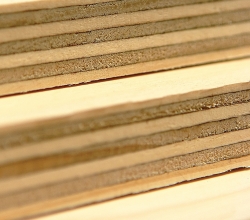The need for sealing both faces and edges of wood based panel products.
Many of the problems that can beset any woodbased panel products in situ could be avoided if the faces and edges were sealed against any moisture absorbtion before being installed. Water penetration can lead to the premature failure of any woodbased panel products. Water is absorbed much faster on the edges of an unprotected panel because most of the wood exposed can be end grain. The effect of water penetration through non protected edges/faces can lead to the following faults:
1. Edge swelling
2. Discolouration
3. Mould development
4. Staining
5. Delamination
6. Decay
It is important to remember that even where a fully exterior adhesive has been used in manufacture repeated wetting and drying of the board can give rise to splitting, cracking and delamination. When choosing a sealant the most important factor is that it is impervious to water.
Panel products for use in external conditions
Some woodbased panel products can be used in demanding exterior conditions. However, to be fully fit for purpose they must be correctly specified, installed and maintained. The term exterior use covers a wide range of situations from where the panels may be in contact with water to where the panels are only subject to occassional wetting. There are two important concepts to consider when specifying a panel product for exterior use:
1. Service class
2. Hazard class
Service classes are used in structural design to define the environmental conditions in service which affect the mechanical performance of a panel under certain conditions. Hazard clases deal with the risk of biological attack. Both of these classes are used to determine the suitability and correct treatment of a product for constructional purposes. The fact that a plywood may have been manufactured with an exterior glue does not mean or imply that it is suitable for long term exposure to exterior conditions. Most situations will require a durable veneer species along with an effective coating or preservative treatment.
Specifying panel products for structural use.
The most effective way of specifying a panel product for structural use is to require compliance with the harmonized standard BS EN 13986. Most panel products that are intended for structural use are internationally traded and therefore are likely to carry a CE mark. Products that meet the requirements of the structural standards should be marked FLOOR S/ROOFS/WALLS. These panels should meet the requirements of BS EN 12871. For a plywood to be CE marked for Service Class 2 conditions it must comply with grade EN 636-2S.




